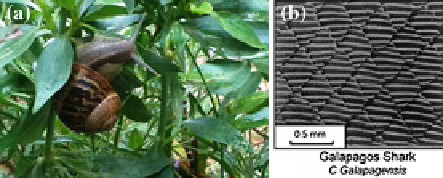Environmental Engineering Reference
In-Depth Information
Fig. 9.8 a snails show outstanding self-cleaning behavior in wet environments; b scale pattern of
a Galapagos shark (Adapted with permission from Reif
1985
)
In fact, snail shells are naturally oleophilic—they show a contact angle of oil in
air of approximately 10—but they can be turned into superoleophobic, with
contact angles of oils higher than 150 when immersed in water, or when covered
by a water layer. Once more, surface chemistry and microstructure are responsible
for this behavior: the protein-coated shell has three ranges of millimeter and
micrometer wide grooves that create a hierarchical pattern, where water can be
trapped, hindering the direct contact with oil (Nishimoto and Bhushan
2013
).
Analogous results can be achieved by mimicking fish scales, and specifically
shark skin. Initially studied for the low drag properties that account for sharks
speed (Bechert et al.
2000
; Krieger
2004
; Dean and Bhushan
2010
), the scales
microstructure (Fig.
9.8
b) was recently connected to the possibility to create self-
cleaning surfaces. In fact, each scale presents a precise texture of riblets parallel to
swimming direction, which deviate water flow and vortices while swimming at
high speed, reducing the contact area with turbulent flow and therefore minimizing
friction and shear stresses. In parallel to an improvement of drag properties, this
microstructure decreases microorganisms adhesion and therefore biofouling, and
increases surface washing (Bixler and Bhushan
2012
; Nishimoto and Bhushan
2013
). In 2007, Schumaker and coworkers proposed several substrate topographies
inspired to shark skin, and evidenced the dependence of biofouling reduction—in
terms of zoospores adhesion—on the dimensions of geometrical protrusions.
9.2.4 The ''lotus effect''
In spite of the growing scientific, technological, and industrial interest in the
natural systems previously described, the most representative case of biomimicry
remains the ''lotus effect,'' named after the lotus—Nelumbo nucifera—leaf self-
cleaning capability, which now counts hundreds of scientific publications and
several dedicated websites.
Although lotus has always been considered an icon of purity in ancient oriental
societies, thanks to its perpetual cleanliness even in muddy waters, Barthlott and
coworkers
were
pioneers
in
investigating
lotus
surfaces
and
identifying
the

Search WWH ::

Custom Search